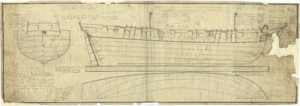HMS Beagle (1804) facts for kids

Beagle
|
|
Quick facts for kids History |
|
|---|---|
| Name | HMS Beagle |
| Namesake | The Beagle breed of dog |
| Ordered | 22 May 1804 |
| Builder | Perry, Wells & Green, Blackwall Yard |
| Laid down | June 1804 |
| Launched | 8 August 1804 |
| Completed | By 7 October 1804 |
| Commissioned | 1804 |
| Out of service | 1813 |
| Honours and awards |
|
| Fate | Sold on 21 July 1814 |
| General characteristics | |
| Class and type | 18-gun Cruizer-class brig-sloop |
| Tons burthen | 38282⁄94 (bm) |
| Length |
|
| Beam | 30 ft 6+1⁄4 in (9.3 m) |
| Depth of hold | 12 ft 10+1⁄2 in (3.92 m) |
| Sail plan | Brig rigged |
| Complement | 121 |
| Armament | 18 guns:16 × 32-pounder carronades + 2 × 6-pounder bow guns |
HMS Beagle was a fast sailing ship, a type called a brig-sloop. It had 18 guns and belonged to the British Royal Navy. It was built in 1804, during a time of big wars called the Napoleonic Wars. The Beagle was very important in a famous sea battle called the Battle of the Basque Roads. The ship was put out of service in 1813 and sold in 1814.
Contents
Life of the Ship: HMS Beagle at Sea
The Beagle began its service in August 1804. Its first commander was John Burn. He sailed the ship to the Mediterranean Sea. In December 1804, the Beagle captured a Spanish ship named Fuenta Hermosa.
In January 1805, the Beagle captured another Spanish ship, the Pastora Hermosa. This ship was carrying valuable gold and silver. After this, the Beagle joined a group of British ships near Cádiz, Spain.
Commander Francis Newcombe took charge of the Beagle in February 1806. The ship stayed in the Mediterranean until 1807. Later, it moved to an area called the Downs in England. The Beagle operated there from 1808 to 1809.
Capturing Enemy Ships
While Commander Newcombe was in charge, the Beagle caught three privateers in the English Channel. Privateers were private ships allowed to attack enemy ships during wartime.
- On October 2, 1808, the Beagle captured a privateer named Hazard. This ship had 14 guns and 49 men. The Beagle chased it for three hours.
- On January 24, 1809, the Beagle captured Vengeur. This privateer had 16 guns and 48 men.
- On February 18, 1809, the Beagle caught Fortune. This ship had 14 guns and 58 men.
These captures helped the British Navy keep the seas safer during the wars.
The Battle of the Basque Roads
The Beagle played a brave part in the Battle of the Basque Roads in April 1809. It arrived on April 10, bringing special fireships to attack the French fleet.
The next day, after a successful fireship attack, the Beagle was one of the first ships to help Lord Cochrane's ship, Imperieuse. The crew of the Beagle cheered for Cochrane when they arrived. A team from the Beagle helped capture and burn a large French warship.
The Beagle also helped bombard French ships. It moved skillfully to fire its guns, unlike some other British ships that just anchored. Commander Newcombe and the Beagle ignored an order to retreat. Cochrane asked the Beagle to protect another ship, Aetna. Newcombe placed the Beagle between Aetna and the French battleships that were stuck. Because of this brave move, the Beagle took heavy damage to its ropes and sails. It also used almost all its gunpowder. Only one man on the Beagle was wounded.
Commander Newcombe was promoted to post-captain because of his courage in this battle. Years later, in 1847, sailors who fought in this battle received a special medal.
Later Years of Service
After Commander Newcombe's promotion, Commander William Dolling took command of the Beagle in 1809. In July and August, the Beagle took part in the Scheldt operations. This was a large British military operation.
The Beagle continued to patrol the seas.
- In November 1809, the Beagle helped recapture a ship called Mount Royal.
- In February 1810, it recaptured a brig (a type of sailing ship) named Resource.
- In October 1810, the Beagle captured a smuggling boat called Ox.
In June 1810, the Beagle captured more smuggling boats. Its officers and crew even bought and sold the cargo from two of these boats.
Commander John Smith became the Beagle's commander in August 1811. In August 1813, the Beagle and other British ships captured a ship named Marmion.
The Beagle also helped in the Siege of San Sebastián in 1813. This was part of the Peninsular War in Spain. The Beagle's crew helped move heavy 24-pounder guns up a steep island. They set up their own battery (a group of guns) to fire at the city of San Sebastian. Commander Smith was slightly wounded during these operations. In 1847, those who fought in this campaign also received a special medal.
End of Service
The Beagle was put out of active service in Plymouth in 1813. It was then sold on July 21, 1814, for £900.

